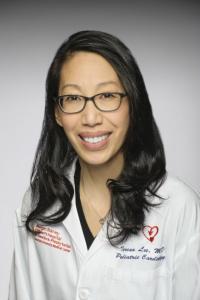Using Genetic Tools to Uncover Causes of Infantile Cardiomyopathy
Cardiomyopathy, a disease of the heart muscle, can cause heart failure and patients often eventually need heart transplantation. When adults develop cardiomyopathy it can be secondary to other diseases such as coronary artery disease, or from genetic mutations that affect the heart muscles cells. In the rare cases that children develop cardiomyopathy, less is known about the cause but it is more likely to arise from a genetic mutation. The outlook for children with the disease is often worse than that of adults, and in infants cardiomyopathy can progress rapidly and be fatal.
Columbia physician-scientist Teresa Lee, MD, MS is board-certified in pediatrics, pediatric cardiology with advanced training in heart failure/transplantation, and clinical genetics. Her unique combination of training and expertise enables her to bridge the fields of genetics and cardiology, and to fill an important niche in translational molecular genetic cardiology research. She has focused her research on understanding the genetic causes of infantile cardiomyopathy, and has been funded by the National Institutes of Health for this work.
While adult-onset cardiomyopathy is often “autosomal dominant,” meaning affected individuals inherit the abnormal gene from one parent, the genetic mutations that cause cardiomyopathy in children are much more varied. These mutations can be spontaneous, “de novo,” mutations—caused by genetic errors that occur in the egg, sperm, or very early after conception. They can also be "autosomal recessive," in which each parent has both a mutated gene and a working gene, and no sign of disease. Children can inherit a mutated version of the gene from both parents, and will go on to develop the disease.
Dr. Lee collects DNA samples from both parents and the affected child, and performs whole exome sequencing (sequencing all of the protein-forming parts of the genome) for each member of the trio to understand the genetic basis of cardiomyopathy in the child.
One candidate gene identified by Dr. Lee and colleagues stood out because it is linked to other types of cardiomyopathy, she says. Along with stem cell biologist Masayuki Yazawa, PhD, she has created a mouse model of this mutation. “These mice seem to display a very similar disease, providing confirmation that we are on the right track. Our hope is that we can correct the mutation and ‘rescue’ the disease in the mice,” she says.
Dr. Lee also studies specific mutations using a technique called induced pluripotent stem cell technology. Cells taken from a patient’s skin, blood, or hair, for example, can be returned a very primitive state called pluripotency, where they regain the ability to become any cell in the body. “We can reprogram a blood cell to become a heart cell, and we now have, in a Petri dish, heart cells from my patient that contain not only the mutation causing the heart disease, but all of the other genes that might be modifying it,” she explains. “And then we can bathe the cells with different drugs and predict what might work best without having to give my patient multiple different treatments.”
The overriding goal of Dr. Lee’s work is to identify targets for new molecularly based therapies that take aim at the underlying genetic defect. With rapid advances in genetics and cardiology, the goal seems closer now than it did a decade ago when Dr. Lee began her career. “This is a very exciting time to be a physician-scientist in these two very progressive fields,” she says. “During my very short career both genetics and cardiology have changed so dramatically. Genetic tools are much more powerful and provide results much more quickly, and surgical devices are tinier and tinier, and we're able to support babies on machines that did not exist years ago. But although we've got great surgical outcomes and great transplant options, I hope we can do better by filling in the knowledge gap and understanding what this disease is and how it's working.
“Many children diagnosed with cardiomyopathy will need a heart transplant,” she adds. “So it would be amazing if we were able to find a way to correct the disease in babies, and set their lives on a different trajectory. As much as I love being a transplant doctor, I'd be very happy for the day where I don't have to do quite as many transplants.”

